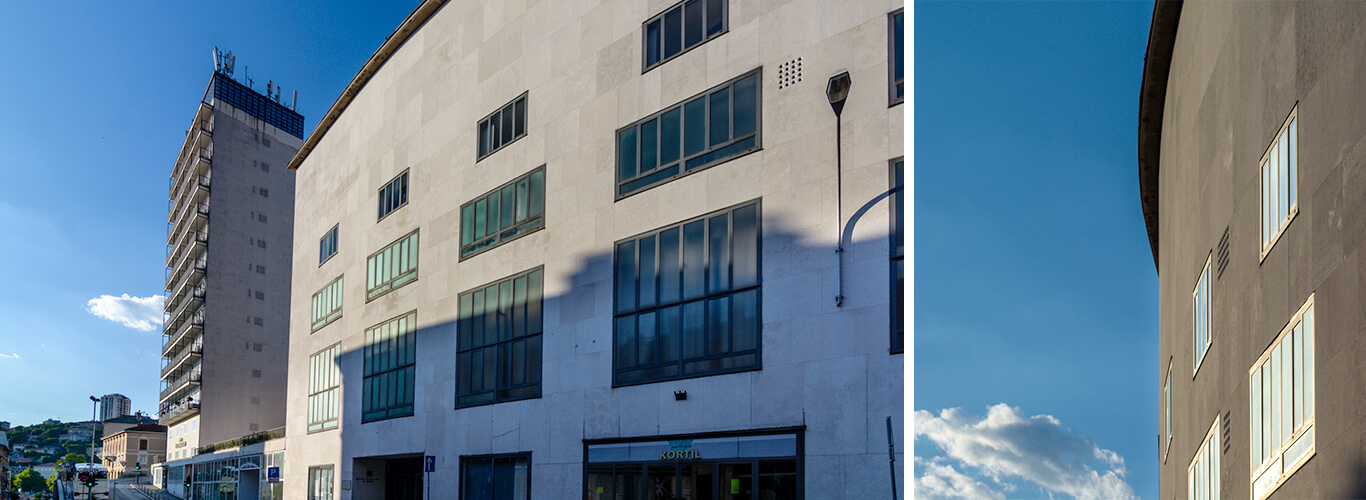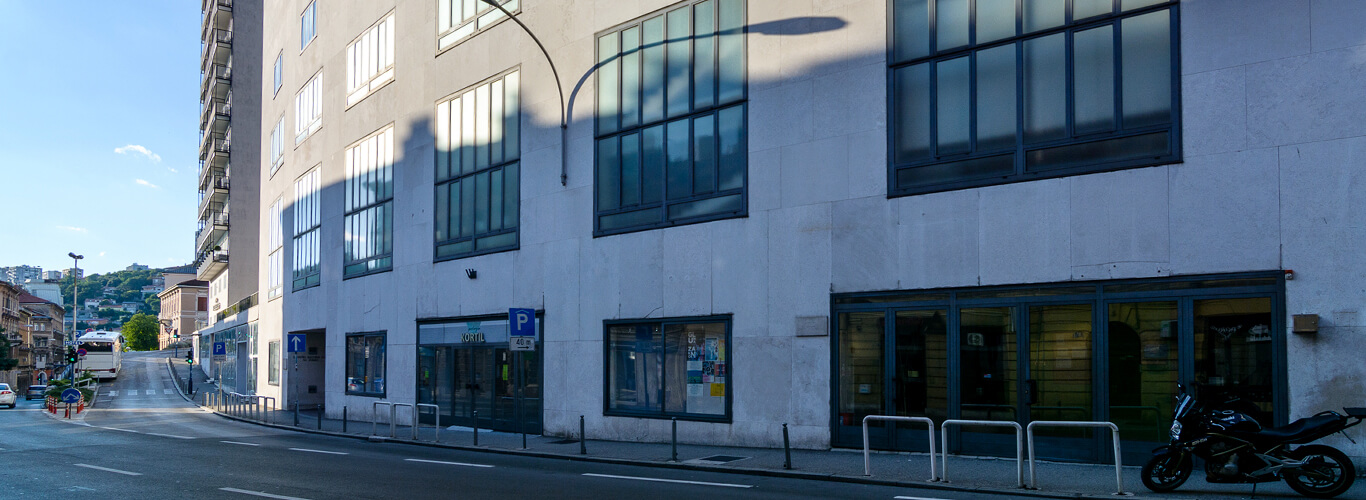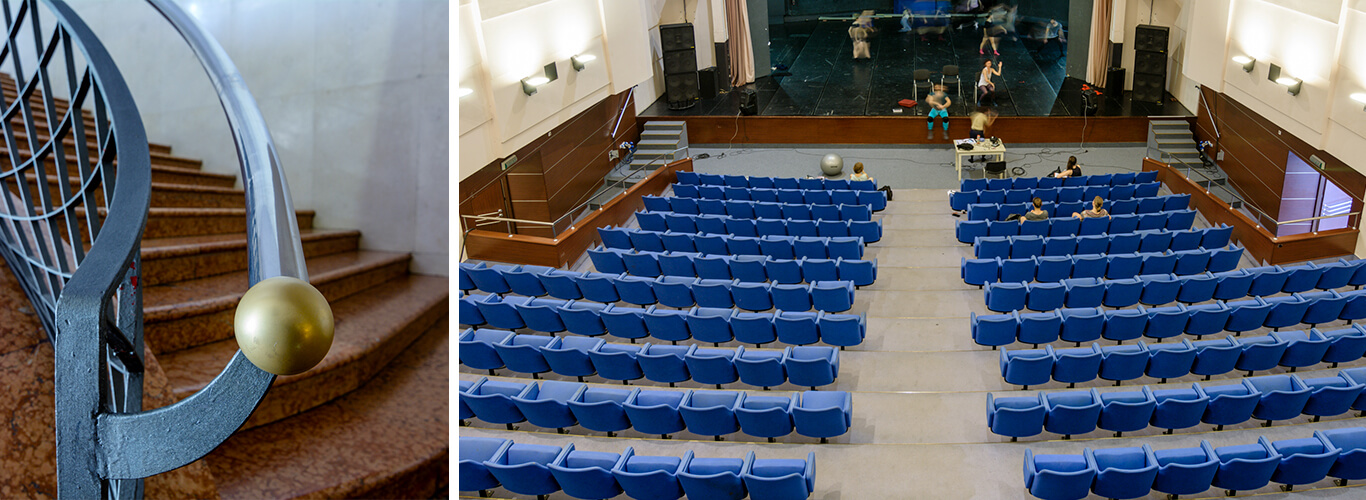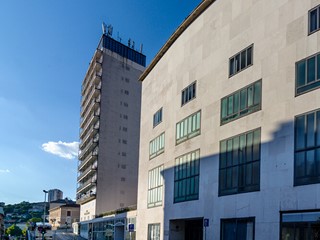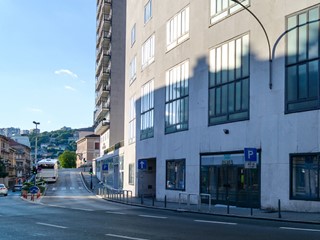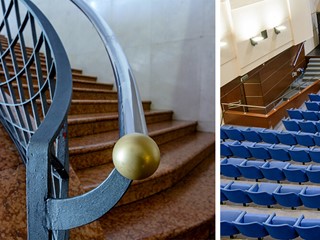Croatian Cultural Centre on Sušak
address: 26 Strossmayerova StreetPeriod: Modernism
Kind: Immovable material heritage
Century: 20
Year: 1936
Purpose: cultural
The Croatian Cultural Centre on Sušak was built from 1936 until 1947 according to the project by Josip Pičman. Owing to the author's premature death, the project was readjusted by Alfred Albini.
The building was constructed because the city of Sušak needed a place to hold cultural and social manifestations, but also because of the lack of accommodation capacities. The considerations about such an edifice can be followed since 1907, but the tender and the beginning of construction were realized between the two wars, when the mayor was Đuro Ružić and Sušak was a part of the Kingdom of Yugoslavia. The reason for this investment was the rivalry between Sušak and Rijeka, then a constituent part of the Kingdom of Italy, which built monumental edifices – the Rijeka Skyscraper and the Votive Temple on Kozala. The Sušak Skyscraper was constructed as a counterpart to the Rijeka Skyscraper, symbolizing the then progress of the Kingdom of Yugoslavia.
A total of 59 project proposals by renowned architects from the entire country arrived for the tender, therefore winning it meant a true compliment to the awarded architect. Josip Pičman made the project in cooperation with Ivo Richtmann and Marko Jurinšić, and he managed to satisfy all tender criteria by uniting cultural, social and tourist demands on this location. In the project, these functions were still separated in two buildings, connected in the middle by a square/terrace, providing the complex with a rhythm and airiness.
During his career, Josip Pičman faced many difficulties. His projects often won at tenders, but owing to financial, political or other reasons, they were never realized. Owing to similar reasons, the beginning of construction of the Croatian Cultural Centre on Sušak was also delayed. The tender was published in 1934, while its realization started in 1936, so Pičman believed that this project would also be abandoned. Before he received the notice about the beginning of construction, he had taken his life.
The construction was then taken over by Alfred Albini, a professor of Architectural Compositions and Architecture of the New Age at the Faculty of Engineering in Zagreb. Albini considerably altered Pičman's project, owing to his different views on architecture, as well as financial difficulties, which is why construction was prolonged to ten years instead of the expected twenty months. He removed the planned seawater pool, the terrace, the mobile glass roof and the residential part and he narrowed the hotel building. He decided to cover the façade with Brač stone, contrasting its monumentality with glass windows. The hotel building was enclosed on all sides, except towards the sea.
The Croatian Cultural Centre on Sušak is still a monumental edifice which at that particular moment, as well as today, fulfilled all needs of the citizens of Sušak and Rijeka. It organically fits into the space following the line of the road, thus gaining a rounded façade. The style of construction reflects the modernistic views and the clarity of construction. On the outside, the entire complex seems unique, while the interior achieves a clear division of content. Innovation can be recognized in the use of material, the reinforced concrete construction and concrete and steel beams. Although Albini made some changes, the building did not lose its airiness, while his use of stone provided it with monumentality.
The construction prolonged due to several reasons – the sea flooded while drilling the foundation and the workers went on strike. Political problems occurred when the mayor Ružić decided to rename it into Croatian Cultural Centre, which was seen by the state authorities as separatist.
The construction project of such a complex was one of the most demanding in the state, as well as in Europe.
Valorization:
The Croatian Cultural Centre on Sušak was restored after the Second World War under the guidance of the architect Kazimir Ostrogović.
The business section and the foyer were restored in 1996 under the guidance of Rijeka-projekt (architects Antolović, Pavoković, Persić).
The construction in not on the List of Protected Cultural Goods in the Republic of Croatia Register of Cultural Goods.
Bibliography:
HKD na Sušaku: Povijesni i suvremeni kontekst. Moja Rijeka,10/6/2011. Link: http://www.mojarijeka.hr/kultura/hkd-na-susaku-povijesni-i-suvremeni-kontekst/
LozziBarković, Julija, Arhitektura Rijeke I Sušaka između dva rata (1): HKD u sjenitragedije, Novi list, 16/3/2015. Link: http://www.novilist.hr/Kultura/Arhitektura-Rijeke-i-Susaka-izmedu-dva-rata-1-HKD-u-sjeni-tragedije
Dubrović, Ervin, Dva nebodera – nacionalno I internacionalno u arhitekturi tridesetih godina u Rijeci I Sušaku viđeno u širem kontekstu, Peristil, no. 31-32, 1988/1989, pp. 329–336.
Matejčić, Radmila, Kako čitati grad, Publishing Centre Rijeka, Rijeka, 1990, pp. 441–448.
Lozzi Barković, Julija, Međuratna arhitektura Rijeke i Sušaka, usporedba i europsko okruženje, Adamić, Rijeka, 2013, pp. 247–266.
Lozzi Barković, Julija, Javno graditeljstvo Sušaka između dva svjetska rata s osvrtom na dosadašnja istraživanja, Book of Proceedinga from the I. Congress of Croatian Art Historians, 2004, pp. 167–174.
Lozzi Barković, Julija, Hrvatski kulturni dom u Sušaku – prilog istraživanju I valorizaciji, in: Journal of the Institute of Art History, 2005, pp. 287–306.
Lozzi Barković, Julija, Svilup po urbano di Sušak, in: prof. dr. sc. Elena Marchigiani and prof. dr. sc. Paolo Nicoloso, Itinerari at traverso I luoghi de lmoderno. Strategieper la 'costruzione' identitariadel confine Italo-Yugoslavo, tra e oltre le due guerre, University of Trieste, Trieste, 2008.
Julija Lozzi Barković, Casa della cultura a Sušak, in: prof. dr. sc. Elena Marchigiani and prof. dr. sc. Paolo Nicoloso, Itinerariattraversoiluoghidelmoderno. Strategie per la 'costruzione' identitariadel confine Italo-Yugoslavo, tra e oltre le due guerre, University of Trieste, Trieste, 2008.
Rački, Andrija, PovijestgradaSušaka, Publishing Centre Rijeka, Rijeka, 1990.
Bradanović, Marijan, O Hrvatskom kulturnom domu, in:Sušačk arevija, vol.4.,no. 13, 1996, pp. 39–41.
Žic, Igor, Hrvatski kulturni dom, Sušačka revija, vol. 2, no. 8, 1994, pp. 23–28.

